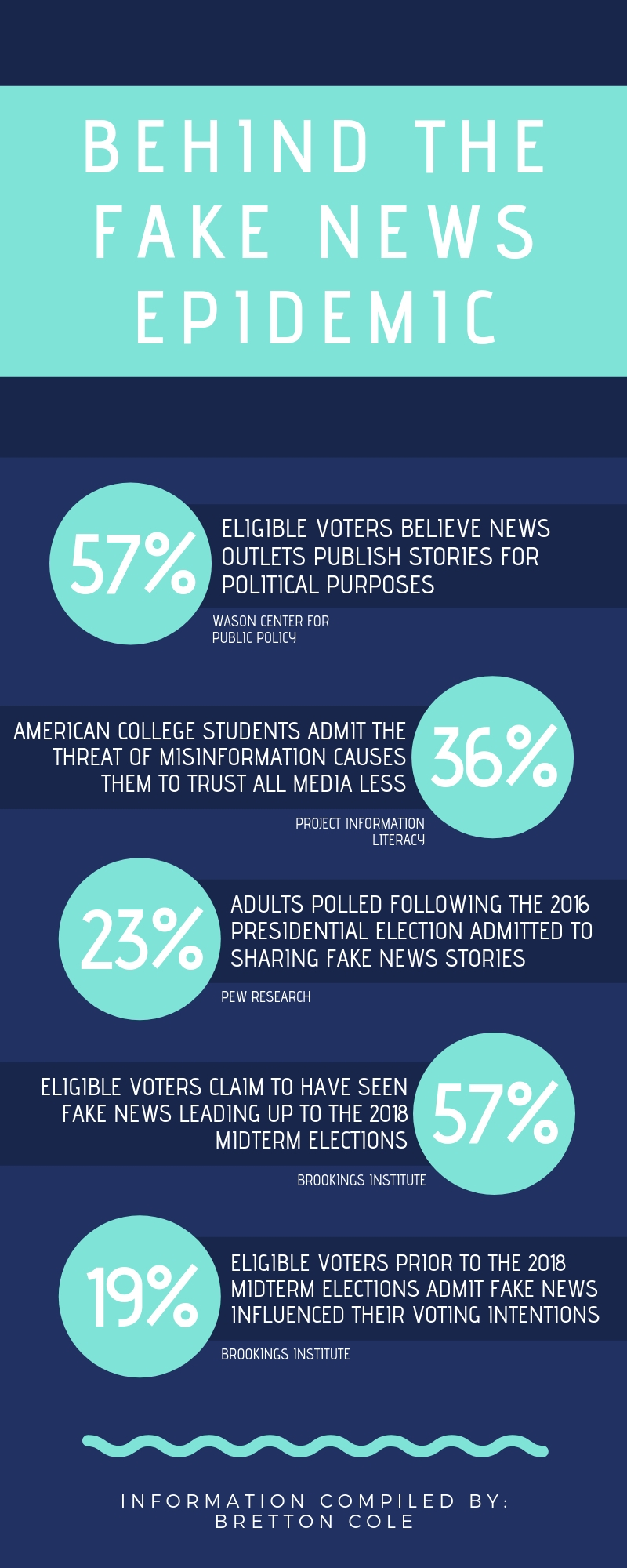Bretton Cole
Editor-in-Chief
With the dawn of internet and social media, the spread of information has grown considerably; unfortunately, that increase has resulted in the dissemination of fake news.
Yet, colleges and universities are uniquely positioned to combat the spread of disinformation by using education and modern technology to teach and solve the growing crisis of fake news.
There is growing concern, particularly among college age students, about fake news and its implications on students. The reason is simple: our nation’s most equipped digital natives, high school and college age students, are struggling, along with the older generations, to separate real news from fake news.
Understanding the dangers of fake news helps bring into focus the burden and obligation colleges have to appropriately address the issue before it spirals out of control. The Stanford History Education Group published a study in 2016 pointing out how students, from middle school to college, have significant trouble identifying fake or misleading news.
It comes as no surprise students struggle to identify fake news, however. According to the Stanford study, 89% of students receive their news primarily from social media, a breeding ground for disinformation and fake news.
Typically, colleges let this stream of uninformed students float through their campus. Their need to be informed is left unmet and their ignorance is left to grow. The concern is people become cynical to the point where truthful news becomes obsolete and untrustworthy based on the bad reputation of sensational fake news websites.
Leaving students in this impaired condition brings on a lot of issues, ranging from cynicism toward all media to voting habits
The damage of fake news is not irreversible, however. Fake news seems to overtake the Internet and social media websites, and has seemed to add fuel to the fire, so what can education systems realistically do when posed with such a harmful threat?
The Internet leaves us with only two options when it comes to fake news: fight or flight. We can run from the source or fight it. The Internet is not going away, so we ought not to run from it. Rather, we fight by teaching students how to use it.
In San Mateo, California, at Aragon High School, history teacher Will Colgazier is embracing the idea of education to combat fake news. He teaches his students the importance of digital literacy when surfing the web – including accuracy mining assignments into his curriculum.
Dr. David Schieffler, a history teacher at Crowder, explains that using a historian’s approach is the best method to solving the problem of fake news.
“Every day,” Schieffler elaborates, “[historians are] using sources to build arguments and trying to figure out which sources are accurate which aren’t.”
It is the very nature of historians to verify sources so they can depict an accurate scene of what really went on in times before the present. Those rules, he suggests, ought to be extending to surfing the web.
Schieffler stresses the concept of lateral reading. Essentially, this means going back to Google where most searches often originate and seeking validation for the source from which the information comes. He encourages students to see what other sources are saying about the site or organization to substantiate credibility.
Colleges are finding the best ways to push back against the influx of fake news is to use the knowledge and strengths of the students as integration techniques into education practices that will both practically work against fake news, but will also help educate students on how to avoid being duped themselves.
The Internet is a tool, useful for nearly any discipline. However, it can also be used as weapon, a threat to the survival of the republic.
“We live in a country which has a democratic system,” Schieffler noted, “In order for us to make informed votes, we have to have reliable information.”
Without news we can trust, fake news becomes a weapon against the people rather than a freedom for the people – – and the greatest venue for either is the application of the Internet.
Fake news is only as powerful as ignorance allows it to be, so the paramount solution is an educated, informed public. Historians teach us the methods of ensuring sources are accurate and verifiable. It is up to colleges to engage in those disciplines as part of their education for students
The Internet will never go away, so the only way to avoid the dangers it brings via fake news is to teach college students, the next generation of those in authority, how to use it properly.
Educating a vulnerable, yet powerful public is the antidote – the cure – to the fake news epidemic.






Leave a Reply